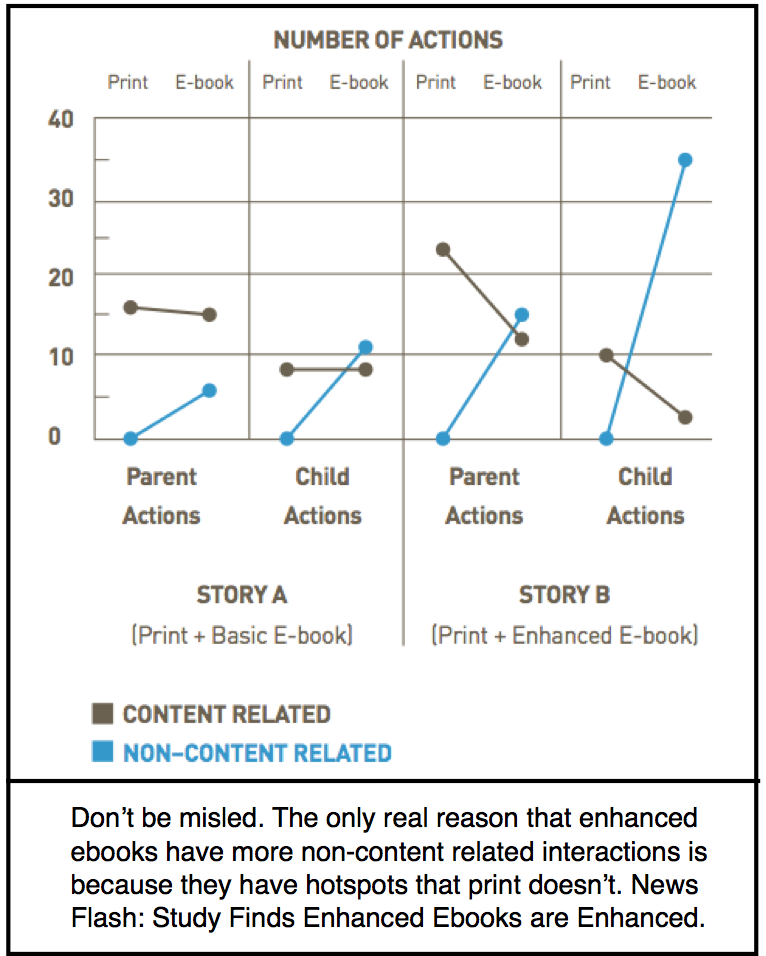
This week, the Joan Ganz Cooney Center discovered that ebooks and print books are not that different unless you take an enhanced ebook designed for independent use and try to force it into a co-reading situation. Or at least that is what their report “Print Books vs. E-Books” (PDF format) says if you read beyond the shocking headlines from news coverage of this non-story. The real literacy issue here is reading beyond the misleading graph that the Cooney Center decided to highlight on the first page of the report. Looking at the data and methodology for the study reveals a very different story.
For this “quick” study, the Cooney Center observed interactions between 32 pairs of a parent and child (ages 3–6). The study included 11 boys and 21 girls mostly from white, middle or high socio-economic families who read with mothers in 66% of the scenarios. The parent/child pairs were asked to read a print book paired with either its basic ebook or enhanced ebook version.
So what we have here a very small sample size (of questionable variety in its demographics) and a study looking at whether it is more or less effective to co-read with an enhanced ebook version designed for independent interactions. Obviously, the study found that the book designed for independent reading was not as good for co-reading.

The critical issue, however, is in which ways it was less effective. This is where the Cooney Center report is misleading . . . almost to the point of an outright lie. Finding 1, a large graphic taking up a full half of the content area on the first page of the report, includes a graph showing that when presented with an enhanced ebook, parents and children went from zero noncontent-related interactions to 15 for parents, and 35 for children. Wow! That is incredible. . . . But wait, what is a noncontent interaction? According to the text above the graph: “The enhanced e-book, prompted more noncontent related actions (e.g., behavior- or device-focused talk, pushing hands away) from children and parents than the print books.” Oh, so when reading enhanced ebooks, parents and children are pushing each other and talking about the device more than they are reading. That doesn’t sound good. Maybe we should check the data summary before we freak out though.
Well isn’t that odd. The data table shows that there were no real changes in instances of negative behavior for parents and children between print and electronic books. Even in the case of the enhanced ebook (remember, the one with the huge spike in noncontent-related interactions like pushing) there is no change. The study found an average of 0.1 child negative behaviors with the print version and 0.1 child negative behaviors with the enhanced digital version of the same book. So why the huge spike in the graph along with the misleading description of what a noncontent interaction is?
Well, the spike comes from children interacting with hotspots and other features of ebooks. In fact, the Cooney Center’s definition of noncontent-related activities as seen in the data summary includes only categories that would be found in digital books: “Parent [or Child] talks about book features” and “Parent [or Child] hotspots.” Is it any wonder that neither parents nor children overlooked the so-called features of the print books they are familiar with and noticed the differences in the electronic versions? Is it any wonder that the children were unable to press any hotspots in the print version but found an average of 34.6 hotspots in the enhanced ebook to press? How is this even scientific?
In short, the alarming increase in noncontent-related activities that the Cooney Center misleadingly highlights in their opening graph is almost entirely attributable to children interacting with the content-related hotspots in the enhanced ebook version that are obviously not present in the print version. This is not a failure; this is the intended and indeed desired result of providing enhancements to a digital book. This is not, as the text of Finding 1 misleadingly suggests, a case of children and parents regressing to pushing and shoving, in fact there were no real negative behaviors in either print or electronic reading scenarios.
The only statistically significant findings from this study are that parents and children tend to label things or point to pictures/text less when reading an enhanced ebook as compared to either a print version or a basic ebook. My guess would be that is because the enhanced ebook is likely providing enough highlighting and attention focusing that neither parent nor child felt they needed to provide additional attention cues. The other statistically significant difference was that children were more distracted while reading the print version (4.1 average distracted moments) as opposed to the basic ebook version (2.3 average distractions). The pair of print and enhanced versions of the same book had no real differences in level of engagement. The possibility here might be that the title selected for the print/basic ebook comparison was itself not a very engaging book. Therefore using a basic ebook version might have increased engagement.
In the end, the Cooney Center report provides the best summary. “This research was conducted with only 32 families and two specific ebook titles, which limits the generalizability of its findings to the wider population of families or ebooks.” Not that this has stopped either the Cooney Center report itself or many of those covering the report from attempting to use this non-data to attack ebooks.
What the study really shows is that enhanced ebooks are not the best choice of medium for co-reading with a child. Libraries need to provide parents with instruction in selecting resources for co-reading.
